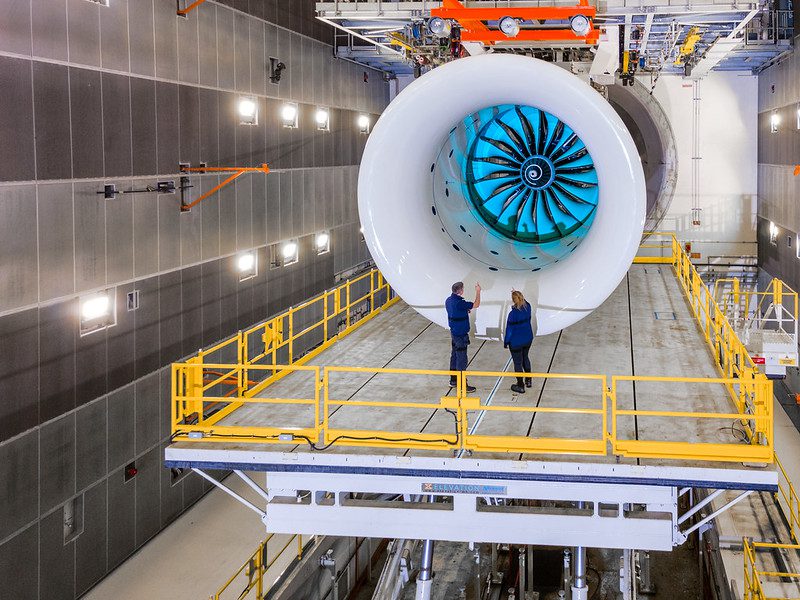
52900108748 d9f95e4b09 c
Rolls-Royce has run the first test of the UltraFan technology demonstrator engine. The test was successfully completed using Testbed 80 in Derby, where preparations have been underway since December. The engine maker issued an embargoed press statement on Wednesday evening, which didn’t disclose when the test was actually performed. Rolls-Royce UltraFan demonstrator completes first test.
The first test of UltraFan UF001, which ran on 100 percent sustainable aviation fuel (SAF) made from used cooking oils produced by AirBP, is a milestone for Rolls-Royce. The UK company has been working on the project for a decade, combining technologies from other large engine programs into one.
Like the 140-inch composite fan with eighteen carbon composite titanium blades, which has been tested under the Advanced Low-Pressure System (ALPS). Behind the fan is the Power Gearbox (PGB), a novelty on a Rolls-Royce large turbofan. Like the Pratt & Whitney Geared Turbofan, the PGB on UltraFan allows the fan at the front and turbines at the back of the engine at their optimum speed. The PGB has been tested since 2017 in Dahlewitz (near Berlin) and has produced 64 megawatts of power, a record in aerospace, according to Rolls-Royce.
UltraFan also includes a lean combustor with low nitrogen oxide emissions and lower particulates. A demonstrator has been tested since 2018 as the Advanced Low Emissions Combustor System (ALECSys).
At the heart of the engine is a compact core called Advance3, as it is the third iteration of the Advance project. It includes a two-stage High-Pressure Turbine (HPT) and a single-stage Intermediate Pressure Turbine (IPT). Advance3 has been tested on a hybrid engine that had the fan system of the Trent XWB and the Low-Pressure Turbine system of the Trent 1000. The overall pressure ratio of the UltraFan is 70:1.
25 percent more efficient
UltraFan has been designed to be 25 percent more efficient than the first generation of Trent 700 engines or ten percent better than the Trent XWB, have forty percent lower NOx emissions, and produce 35 percent less noise. And it is ready to accept 100 percent SAF. At a later stage, the engine should be capable of running on hydrogen and include hybrid-electric elements as alternative sources of power. That’s why the project has been funded under the European Clean Sky 2 technology program and will get new funding under the Clean Aviation Heaven program.
Rolls-Royce’s new CEO Tufan Erginbilgic hailed the first test and UltraFan as “a game changer – the technologies we are testing as part of this program have the capability to improve the engines of today as well as the engines of tomorrow. That is why this announcement is so important – we are witnessing history in the making; a step-change in engine efficiency improvement. When combined with Sustainable Aviation Fuels, more efficient gas turbine engines will be key to hitting the industry’s target of Net Zero flight by 2050.”
The development of UltraFan came amidst one of the most difficult periods of Rolls-Royce when it was confronted with numerous durability issues on the Trent 1000 and 1000 TEN, the Trent 900, and the Trent 7000. These cost the engine makers hundreds of millions to correct. When the large engine market collapsed during the Covid crisis, Rolls-Royce was forced to launch a deep transformation program and slash its workforce by 9.000. Under the new leadership of Erginbilgic, who succeeded Warren East early this year, Rolls-Royce is continuing its transformation into a more efficient and profitable company.
Which aircraft?
Rolls says that “UltraFan is due to be available to the market in the 2030s, with timing determined by airframer requirements and market demand.” It is designed with different power ratings in mind. The problem is that there is no immediate airframe program on the horizon that would require the new-technology engine. UltraFan was a candidate for Boeing’s mid-market aircraft until the engine maker dropped out in February 2019 as the time schedules of the aircraft and engine didn’t match. A year later, Boeing ditched the NMA altogether. President and CEO David Calhoun said last November that a new aircraft will not be launched until sometime in the next decade.
Airbus still needs to make up its mind if a ZEROe hydrogen aircraft that should be available around 2035 will require a large engine like UltraFan. The Europeans are also exploring the General Electric/Safran CFM RISE open rotor program, which will be flight tested on an A380 testbed.
For now, UltraFan could find its way to the replacement market, potentially on the Airbus A350 as the Trent XWB successor or on the Boeing 787 to replace the Trent 1000. The benefits could be attractive, but it all depends on the business case.
Views: 22




